|

by Richard C. Hoagland
2002
from
TheEnterpriseMission Website
Part 1
The below color images of Mars were taken in 1999, across almost 60
million miles (!) by a talented amateur astronomer in Oeiras,
Portugal -
Antonio Cidadao.
They were acquired with a modest
10-inch "Schmidt-Cassegrain" reflecting telescope, and a
commercially available CCD (charge coupled device) camera. Mr.
Cidadao’s total investment in his "Mars imaging system" - commercial
telescope and electronic camera, plus computer to process the
images, and the appropriate software - was approximately three
thousand American dollars...

To get a feel for Mr. Cidadao’s remarkable accomplishment, examine
the following professional color comparisons.
The Observatory image (below, right) was acquired in 1956 by Dr.
Robert Leighton of the California Institute of Technology, using Mt.
Wilson’s famed 60-inch reflector. It was a 20 second exposure on Kodachrome color film, subsequently processed by the Institute’s
well-known research laboratory, "JPL."
The comparison image (below,
left) is one of Cidadao’s 1999 Mars series shown above, when the Red
Planet was almost twice as distant as in 1956. It was a combination
of two images, exposed through red and blue filters for .2 seconds
each - one tenth the Kodachrome exposure!
An "averaged" green image
was subsequently created, and the three images composited to produce
the final color view.
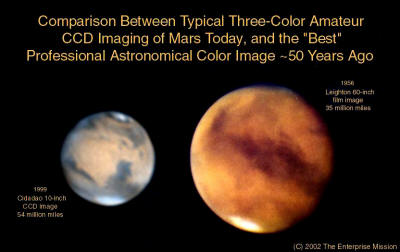
What’s remarkable about this comparison is that Antonio Cidadao’s
amateur CCD image has comparable detail, but truer color (based on
the reciprocity failure of the three-layered color film under long
exposures, and visual telescopic observations by this writer and
others) - compared to the professional "Leighton image," taken (at
the time) through the world’s third largest telescope... 46 years
ago.
A comparison of the sheer physical size of the two instruments
(below) is even more revealing.
That planetary images of the quality of Cidadao’s 1999 Mars record
could have been acquired with such a relatively small instrument -
only one sixth the mirror size of its professional counterpart - is
remarkable.
That it could produce images better than
the 60-inch Mt Wilson instrument, and when Mars was almost twice as
far away as in 1956, is elegant testimony to the starling advances
in the "computer-driven technology of astronomical photography" -
and its democratization within the amateur astronomical community -
that have occurred in only fifty years...
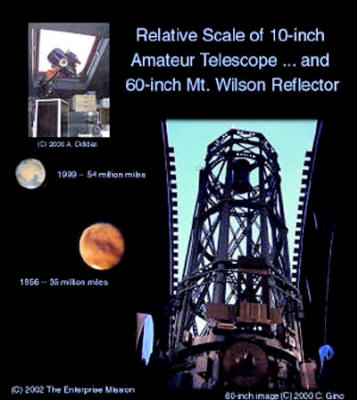
Which brings us to NASA... and the strange tale of
its color imaging
of Mars.
As every space aficionado knows, the Space Agency has another
unmanned spacecraft currently orbiting the Sun’s fourth planet,
called "2001 Mars Odyssey." Odyssey carries an incredibly
sophisticated, one-of-a-kind, solid-state CCD imaging system known
as "THEMIS" - capable of returning both thermal infrared AND
"natural color" images of Mars from a ~250 mile orbit.
According to
official Odyssey documents.
"THEMIS will also acquire 20-m resolution visible images in up to 5
spectral bands. Over 15,000 panchromatic (3,000 5-color), 20 × 20-km
images will be acquired for morphology studies and landing site
selection."
The cost of this latest NASA spacecraft
- including launch vehicle,
control center, tracking system, and ground personal (engineers and
scientists) required to acquire and analyze these close-up Mars
images - is several orders of magnitude greater than Mr. Cidadao’s
modest astronomical investment... on the order of ~300 million
dollars.
Yet, in stark contrast to Antonio Cidadao’s
obvious success in repeatedly taking, computer processing, and then
posting his spectacular color Mars images worldwide on the
Internet...
In the entire year that Mars Odyssey has been in orbit, the much
more extensively-endowed NASA-THEMIS team has yet to process and
release..., even one of those ~3,000... 5-color Mars Odyssey images!
Mars Odyssey arrived at Mars on October 24, 2001. It began its
official "science mission" on February 18, 2002.
Within a few weeks (March 27, 2002) of that beginning of the
"official" Mapping Mission, the THEMIS team established (with great
fanfare, including a
full press release) an official THEMIS "Image
of the Day" website - to (in the words of one THEMIS manager)
communicate "some of the excitement of what we're seeing with the
public." However, almost 250 images later (as of December 8, 2002).
NONE have been the "natural" color images everyone was told were the
unique hallmark of this mission!
For an Agency wanting - in fact, desperately needing - "good PR,"
especially after the debacle of losing two Mars bound spacecraft
back to back in 1999, this failure to put out even one full color
image of their first successful mission back to the "Red Planet"
since those previous disasters is simply "inexplicable."
It was not until October 1, 2002, that we began to have some inkling
as to "why" this apparent "failure" has continued.
For on October 1, NASA officially released almost two thousand
Odyssey Mars images and other scientific data, acquired in the first
six weeks of the official science mission, to the Planetary Data
System (PDS). Among these images were many apparent "full color
attempts," made in those first six weeks with Odyssey’s "VIS System"
(the visual color camera).
These attempts, we duly discovered, were
archived in both the PDS and ASU’s own
THEMIS data bank.
However,
upon downloading many of the B&W filtered images and attempting to
create accurate color images through appropriate compositing, both
we and independent investigators around the world ran into a host of
"technical problems"...
For instance,
Holger Isenberg, the well-known German independent
investigator familiar to many readers here for the role he played a
few months ago in the daytime Cydonia IR controversy, tried his
talented hand at creating an initial real color image from this
official THEMIS data... and he failed (below).

It’s clear from even a cursory glance at his attempted reproduction
of full color, that this representation is NOT yet suitable for
"prime time"; in addition to the annoying overall "green cast" in
the middle of the image, the anomalous additional colors and
"lights" at both ends attest to severe "light scattering problems"
within the VIS camera optical system.
From examination of the
individual B&W filtered images (below), it is readily apparent that
this scattered light is the major constraint to producing any kind
of quality color composite from these "raw," official images.
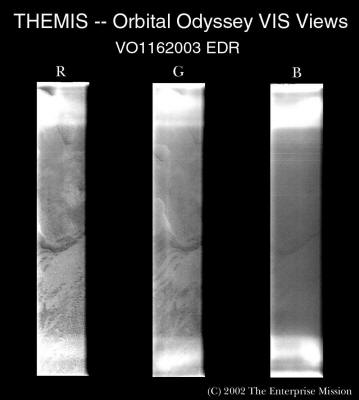
Isenberg’s only comment regarding his failed effort:
"It is apparent
that these images are still uncalibrated..."
More recently, in the general Mars discussion currently occurring at
MarsNews.com, "Bamf" - the notorious computer maven from ASU, who
seems to be making a second career out of visiting various Internet
bulletin boards and providing "ASU commentary" on the on-going
Odyssey mission - was asked about the continuing lack of any "real
color" from the Odyssey Mission:
12th November
[12:45] <ianao> _Bamf_: Why has it taken so long to show color
photos?
12:45] <Bamf> Because it's a hard job to make them.
[12:45] <Woodlock> good question
[12:46] <Woodlock> NASA should work hard.
[12:46] <Woodlock>
[12:46] <ianao> _Bamf_: What makes it so difficult?
[12:47] <ianao> _Bamf_: (In Lamen's [sic] terms, of course)
[12:47] <Bamf> There's 3 or 4 really tough pieces:
[12:49] <Bamf> 1) Each color is taken about 1 second apart. This
means that after you've taken the red picture, you have to wait for
the spacecraft to travel a bit so you can take the blue image of the
same part of the ground. This also means that the planet's rotated
and the spacecraft's wobbled, and other things have occurred to make
the pixels of the red image not line up with the pixels of the blue
image. In addition to motion, different parts of
[12:49] <Bamf> the telescope distort the image differently, so you
have to take out those effects too. This is all called geometric
registration, and STILL isn't complete.
[12:51] <ianao> _Bamf_: I take it that the 3 frames/sec is caused by
compact video equipment?
[12:51] <Bamf> 2) The camera isn't perfect. There's several parts of
the camera that suck, because it was mostly made from off the shelf
parts. One of the really crummy parts is the black part of the
detector array. When you snap a picture, you "shift" it to another
part of the detector so you can read out the values. The "other"
part of the detector is supposed to be completely opaque so
additional light doesn't accumulate. In the wavelengths we use
[12:52] <Bamf> it's not opaque, so it accumulates more data from
other parts of the planet.
[12:53] <Bamf> There's other stuff like this where stray light gets
into the image that has to be taken out. This is called
flat-fielding.
[12:53] <Bamf> (I'll get to your other question in a minute)
[12:53] <Boxman> bamf are there any plans for a probe with
ground-penetrating radar/
[12:54] <Woodlock> But the amazing part about the whole thing is you
still get a photo... of Mars.
[12:54] <Bamf> 3) Each band has to be calibrated. This isn't all
that hard, since the calibration coefficients were measured in the
lab, but the camera doesn't have "red", "green" and "blue" filters,
they're in other wavelengths, and converting them back to something
you can view on your monitor is tough.
[12:54] <ianao> _Bamf_: Please forget about my second question. I
thought you were finished before.
[12:55] <Woodlock> nope
[12:55] <Bamf> Now: The frames/sec stuff is a little strange. We
snap the whole array at once, which is 1 framelet in each band. 1
second later it does it again.
[12:56] <Boxman> Bamf is there any lag between you and the data? do
you see it as soon as anyone/
[12:56] <Boxman> ?
[12:56] <Bamf> I don't think NASA is doing a ground penetrating
radar. There was talk about it for the '05 orbiter, but it didn't
get selected. The ESA Mars Express mission has one through.
[12:56] <Boxman> interesting
[12:56] <Bamf> We get it as fast as it comes down.
[12:58] <ianao> _Bamf_: I am particularly interested in #3, the
calibration. You mentioned use of 'calibration coefficients'. Would
you mind elaborating on what exactly is used to calibrate the
appropriate color bands?
[12:58] <Bamf> Monochromatic filters, ianao. In the lab you measure
the spectral response to monochromatic light.
[12:59] <Bamf> You essentially map out the spectral response of the
filters.
[12:59] <ianao> _Bamf_: I see.
[12:59] <Bamf> Baby's running around, so I might disappear on short
notice.
[12:59] <Woodlock> I don't see.
[12:59] <Boxman> Will the coming war have any effect on your
operations Bamf?
[13:00] <Bamf> Unlikely. There's not a lot of call for the 70m
dishes in war operations.
[13:00] <Boxman> Interesting
[13:00] <ianao> _Bamf_: Thanks for answering my question(s).
In this exchange, "Bamf" (in actuality,
Noel Gorelick - remember,
the official "software Manager for THEMIS data reduction at ASU") is
confirming that "a major problem" exists with the reconstruction of
accurate color images from Odyssey.
Further, he’s specifically
blaming the problem on the camera hardware.
"...there's several parts of the camera that suck, because it was
mostly made from off the shelf parts. One of the really crummy parts
is the black part of the detector array [emphasis added]..."
This is how an official NASA spokesperson for an on-going "make or
break" NASA mission talks about "his" mission?!
What’s really going on here?
In truth, "Bamf" is actually placing the blame not-so-subtly at the
door of another NASA THEMIS scientist... The surprise (to some) will
be in "whom" that is.
Unlike the infrared components of the THEMIS camera (which were
designed and assembled under the direction of ASU’s Dr. Philip
Christensen - "Bamf’s" boss), the VIS side of the instrument
(remember, the one that "sucks") was constructed under the
leadership of one -
Dr. Michael Malin.
That’s right... the same "Dr. Malin" who is Principle Investigator on
the other highly controversial camera system, aboard the other NASA
spacecraft still orbiting Mars... Mars Global Surveyor. The same "Dr. Malin" who, frustratingly, has repeatedly withheld close-up images
of Cydonia (if not a lot of other remarkable locations on the planet...) for well beyond their official "due date" to the PDS.
Realizing this, in the context of Bamf’s many other "inexplicable
actions and ‘outright lies’ on the THEMIS website"
over the past few
months, is it possible that by publicly blaming Dr. Malin’s section
of the camera, "Bamf" is actually trying to tell us that there’s
more to this continuing lack of color imaging than "simple problems
with instrument design?"
Like... "more peculiar rituals and politics re NASA?"
For whatever reason, if you go to Michael Malin’s website, to the
section devoted to his own (too brief!) description of his
VIS
components in the THEMIS camera system, mysteriously... all Malin’s
former links to ASU and THEMIS... now don’t work!
Retribution... for "Bamf’s" curiously caustic,
NASA has a long and curious "history" regarding the "real" Mars...
and certainly its color.
Perhaps the most infamous account is of the controversy that still
swirls around the release by JPL, over a quarter of a century ago,
of the first "true color Viking Lander image," just one day after
Viking touched down in the pre-dawn darkness (Pacific time) of July
20, 1976.
Within a few hours of that historic publication
- the
release of the first color photograph from the surface of Mars -
another, hurriedly revised version of this first color surface image
was suddenly produced - "correcting the initial color engineering
problems" in the first image.
Decades later, one of those personally present at JPL (and curiously
"involved") would relate a very different story of this incident:
The "witness" is the son of the scientist in charge of one of
Viking’s three historic "biology investigations," the Labeled
Release Experiment: Principle Investigator, Dr. Gilbert Levin. His
son’s name is Dr. Ron Levin, now also a scientist - a physicist
-
at MIT.
In the summer of 1976 (when Viking landed), Ron was a
newly-graduated high school student, assisting his father at JPL
during that incomparable "Viking Summer" (where this writer was also
present, covering the extraordinary Viking story for millions of
readers of a major magazine, and a couple of broadcast television
networks...).
The following is from Levin’s first-hand recollections of the whole
affair, recounted in a recent book by science writer Barry DiGregorio
- the remarkable "over reaction" by JPL that occurred in
response to Ron Levin’s naive efforts to "correct" what seemed to
him that July afternoon to be,
"a deliberate - if perplexing -
methodical distortion of the incoming Viking Lander data"
(Mars: The
Living Planet, B. DiGregorio, G. Levin and P. Straat, Frog Ltd,
Berkeley, CA 1997).
According to DiGregorio’s narrative:
"At about 2:00 P.M. PDT, the first color image from the surface of
another planet, Mars, began to emerge on the JPL color video
monitors located in many of the surrounding buildings, specifically
set up for JPL employees and media personnel to view the Viking
images. Gil and Ron Levin sat in the main control room where dozens
of video monitors and anxious technicians waited to see this
historic first color picture.
As the image developed on the
monitors, the crowd of scientists, technicians, and media reacted
enthusiastically to a scene that would be absolutely unforgettable -
Mars in color. The image showed an Arizona-like landscape: blue sky,
brownish-red desert soil, and gray rocks with green splotches...
"Gil Levin commented to Patricia Straat [his co-Investigator] and
his son Ron, ‘Look at that image! It looks like Arizona’ [below].

"Two hours after the first color image appeared on the monitors, a
technician abruptly changed the image from the light-blue sky and
Arizona-like landscape to a uniform orange-red sky and landscape
[below].
Ron Levin looked in disbelief as the technician went from
monitor to monitor making the change.

Minutes later, Ron followed
him, resetting the colors to their original appearance.
Levin and Straat were interrupted when they heard someone being
chastised. It was Ron Levin being chewed out by the Viking Project
Director himself, James S. Martin, Jr.
Gil Levin went immediately
and asked, "What is going on?" Martin had caught Ron changing all
the color monitors back to their original settings. He warned Ron
that if he tried something like that again, he’d be thrown out of
JPL for good.
The Director then asked a TRW engineer assisting the
Biology team, Ron Gilje, to follow Ron Levin around to every color
monitor and change it back to the red landscape.
"What Gil Levin, Ron and Patricia Straat did not know (even to this
writing) is that the order to change the colors came directly from
the NASA Administrator himself, Dr. James Fletcher.
Months later,
Gil Levin sought out the JPL Viking Imaging Team technician who
actually made the changes and asked why it was done. The technician
responded that he had instructions from the Viking Imaging Team that
the Mars sky and landscape should be red and went around to all the
monitors ‘tweaking’ them to make it so.
Gil Levin said,
‘The new
settings showed
the American flag - painted on the Landers - below as
having purple stripes. The technician said that the Mars atmosphere
made the flag appear that way.’"
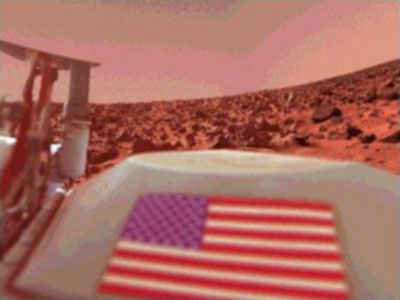
As someone who was also at JPL that afternoon, and vividly remembers
a similar shock - when the "Arizona Mars" initially flashed on the
JPL monitors was suddenly transformed into a Martian "Red Light
District" - I now kick myself for not asking lots more questions.
But, it was 1976 - and we all trusted our Space Agency back then...
One of the basic questions that I should have asked involves the
physics behind JPL’s abrupt color alterations.
Or, as Gil Levin put
it:
"If atmospheric dust were scattering red light and not blue, the sky
would appear red, but since the red would be at least partially
removed by the time the light hit the surface, its [the direct
sunlight’s] reflection from the surface would make the surface
appear more blue than red. There would be less red light [in the
direct sunlight illumination] left to reflect.
And what about the
sharp shadows of the rocks in the black and white images yesterday?
If significant scattering of the light on Mars occurred [from lots
of red dust in the atmosphere], the sharp shadows in those images
would not be present, or at best, would appear fuzzy because of
diffusion by the [atmospheric] scattering [emphasis added]!"
Levin was describing the well-known phenomenon of "Raleigh
scattering" - whereby the similar-sized molecules of all planetary
atmospheres (be it the primary nitrogen of Earth; the carbon dioxide
atmosphere of Mars; or even the predominantly hydrogen atmospheres
of Jupiter and Saturn!) all produce blue skies when sunlight passes
through them.
If you examine the long Martian photographic record - which
encompasses hundreds of thousands of images, acquired by dozens of
observatories even before the Space age dawned - you can see blatant
evidence that Levin’s right and JPL is wrong... regarding the
scientifically expected “color” of the Martian atmosphere.
Here (below) is a comparison of three sets of “tri-color” Mars
images - starting with relatively insensitive photographic plates
in 1909, and ending with a three-color CCD series taken in 2001.
Begun by C.O. Lampland (“CL”) at the Lowell Observatory in 1903,
this type of three-color photography has faithfully recorded the
differences in albedo (reflectance) between the “light areas” and
the “dark areas,” in different color wavelengths, for almost a full
century.
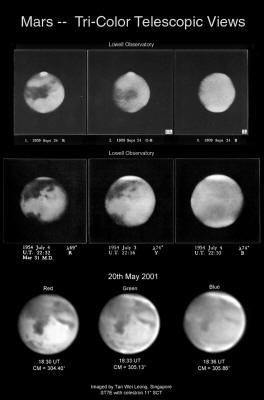
What is immediately apparent in these black and white images is the
simple fact that “red” light records the dark surface markings with
the highest contrast, while “blue” makes them all but disappear.
That this is not purely a result of the marking’s different
reflectivity in red and blue is confirmed by a rare but
well-documented “blue clearing phenomenon” - amply photographed at
times across the years.
Thus, whatever is causing the Martian surface to essentially
disappear in blue light is in the atmosphere...
If the planet’s atmosphere were continually filled with tiny
particles of reddish dust - as NASA has insisted now for more than
30 years - then the contrast would be the lowest in the red.
Instead, as these images attest, the contrast disappears in the blue
region of the spectrum - in precise accordance with Rayleigh
scattering of sunlight!
These conclusions are blatantly confirmed by combining the
three-color images into full color (below) - which show bluish
scattering and hazes widely prevalent across the “salmon deserts” of
the so-called “Red Planet.”
So, what the hell is truly going on with NASA’s “science”…!?
In 1997, before the arrival of the Mars Pathfinder spacecraft (the
first NASA Lander sent to Mars since Viking), the Hubble Telescope
was tasked to acquire a series of "weather forecast Mars images"
prior to the landing (below).
This long-distance reconnaissance
detected a small dust storm less than a month before the Pathfinder
arrival, which (with its potentially high winds) could have posed a
serious threat to the Pathfinder entry and landing.
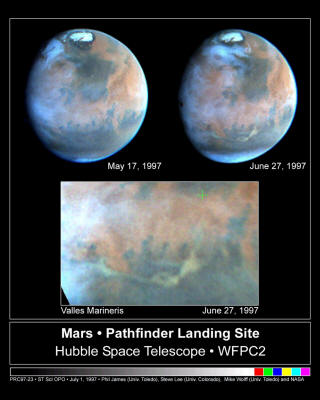
Hubble Investigator on the Pathfinder Landing imagery, Dr.
Philip
James, of the University of Toledo, when the dust storm safely
dissipated (but only after filling Valles Marinaris with suspended
particles - above), did note one potential impact on the Pathfinder
Mission:
"If dust diffuses to the landing site, the sky could turn out to be
pink like that seen by Viking... otherwise [based on the Hubble
images - above], Pathfinder will likely
show blue sky with bright
clouds."
In other words, based on the Hubble images taken just before the
landing, NASA astronomers working with the Hubble data fully
expected a surface view to match what their telescopic images were
showing!
And they did not!
Instead, when Pathfinder did arrive... the skies, according to the
official JPL Lander image releases (below), if anything, seemed
redder and more "dusty" than on the Viking images - twenty years
before!
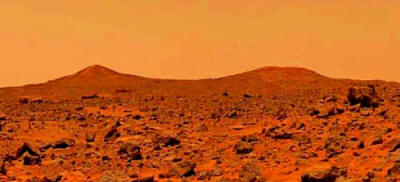
Why?
In the years subsequent to Viking (and before Pathfinder), a variety
of other NASA spacecraft had returned a variety of color views of
Mars.
Remarkably, in all those images (below) the tell tale evidence
of major Raleigh scattering (that bluish limb around the planet,
where the atmospheric path is longest) is blatantly apparent!
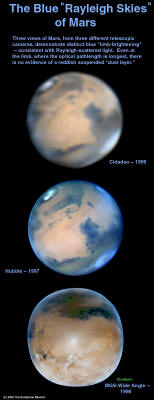
In the three examples displayed here, the top image is an
enlargement of another of Antonio Cidadao’s 1999 Mars images. Note
again the "salmon-colored" deserts, and "blue-green" darker areas
-
as well as hints of bluish tinges at the limb.
The color standards represented by this (and a host of other)
world-wide amateur astronomers’ CCD images of Mars cannot be
overstated; for they are the only basis for a valid (uncensored)
scientific test for real Mars colors, still available to all the
rest of us in 2002...
That being the case, the second image is a "corrected" Hubble view
(using the Cidadao image - and Dr. James own comments - as the
standard). It was acquired just prior to the Pathfinder Landing, in
1997.
Except for the obvious differences in resolution (remember, Cidadao’s image was secured with a 10-inch, amateur telescope,
looking through Earth’s atmosphere... and across 54 million miles),
the colors and features of both images, calibrated to the "salmon
Martian deserts," are the same... including (in the Hubble image,
because of much higher resolution)... a now clearly defined blue-sky
scattering around the planet’s limb!
The third image is an ultra-close-up view of Mars from orbit,
secured only 250 miles above the planet with Dr. Michael Malin’s
wide-angle camera aboard the Mars Global Surveyor spacecraft (MGS),
in 1998 (prepared by independent Mars investigator, Jim Heald).
Because of the MGS low orbit, the distance to the Mars’ horizon (and
thus, greatest optical path through the atmosphere) is only a few
hundred miles in this view (and, because of the "push broom" nature
of the Malin camera, the image is also somewhat distorted from a
circular field of view).
The critical feature of all three images is the now blatantly
obvious, "Raleigh scattered" bluish limb of Mars!
This astonishing fact - an unmistakably "Earthlike" sky on Mars
- is
the exact opposite of what NASA has tried to get us to believe all
these years, and with a variety of now clearly altered Martian
images.
This remarkable scientific and political conclusion is confirmed by
a close-up view (below) of (obviously, now!) the two most
"Earthlike" planets in the solar system... Earth and Mars.
Note the
distinct blue atmospheric layer floating over the russet Martian
deserts in this close-up view, from the wide-angle MGS camera... and
not a trace of reddish atmospheric dust in sight!
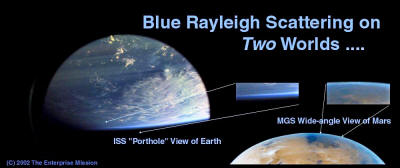
In fact, if you want to really see what the atmosphere of Mars looks
like with a significant amount of dust, one only has to look at this
extraordinarily revealing Hubble image (below) - taken during the
height of the recent global dust storm, in 2001.
We all learn in grammar school that adding "yellow" to "blue,"
creates the color "green."
Well, what do you know...

Adding yellow Martian dust to the Rayleigh-scattering Martian
atmosphere in 2001,
literally turned it green!
Which, of course, would be impossible... unless... there was an
already strong, Rayleigh-scattered blue component to that atmosphere... an atmosphere that
NASA has tried extremely hard to hide... for
over thirty years!
Now, remember that cryptic statement DiGregorio wrote earlier,
regarding "the head of NASA’s role" at the time of Viking’s initial
color image of the Martian surface?
It turns out that his statement was based on a remarkable
confirmation of this 1976 incident... and from an official source -
former JPL Public Affairs Officer, Jurrie J. Van der Woude.
In a
letter to DiGregorio (also reproduced in
Mars - The Living Planet),
Van der Woude wrote:
"Both Ron Wichelman [of JPL’s Image Processing laboratory (IPL)] and
I were responsible for the color quality control of the Viking
Lander photographs, and Dr. Thomas Mutch, the Viking Imaging Team
leader, told us that he got a call from the NASA Administrator
asking that we destroy the Mars blue sky negative created from the
original digital data..."
Destroy official NASA data?!
This bizarre sequence of events raises too many disturbing questions... like...
-
Why was the Administrator of NASA so determined to conceal
the "true" colors of Mars from the American people and the world, in
1976?
-
Why would he order the head of the Viking Imaging Team to
literally eliminate an important piece of historical evidence from
the official Mission archive - the original "blue-sky negative"
- if
the initial release was only "an honest technical mistake"?
-
Wouldn’t that record be an important part of the ultimate,
triumphant story of "NASA scientists eliminating initial scientific
errors, in their continued exploration of the frontier and alien
environment of another world...?"
-
And, why would a young teenager
- and the son of one of the key
investigators on the Viking Mission, no less! - actually be
threatened with expulsion by the Director of the entire Project...
for simply "tweaking a couple of color monitors" around the Lab...?
In truth, none of Ron Levin’s story (or Van Der Woude’s
significant confirmation), makes any scientific sense... unless...
certain individuals in NASA in 1976 felt compelled to hide - and at
all costs - the visible appearance of the actual Martian surface...
Thirty years have now gone by, and some of us (unfortunately, when
it comes to NASA) are considerably wiser. In the interim, because of
the continued democratization of computer technology (and the
existence of the Web), a whole new generation has now been enabled
to revisit those original Mars images... and the crucial questions
that go with them... to investigate for themselves this bizarre
chapter in an "altered Martian story."
From the startlingly simple process of merely reinstating the
original Viking surface color data (now available at certain
official NASA websites), so the flag appears as "normal" (!) (like
in this version, produced by Barry Arneson in 2001 - below), one
gets the distinct impression that "certain individuals" in NASA
-
three decades ago - for some arcane reason, didn’t feel Americans
were "ready" then... to see the real "Red Planet."
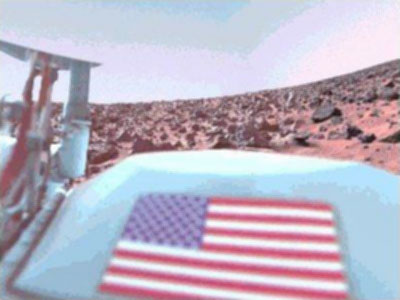
But now - in 2002…?
This lingering, thirty-year-old question - which goes to the heart
of NASA’s entire "game" involving Mars, and what "they" apparently
think we are "ready" to find out - suddenly came into focus all
over again... just a few days ago.
A member of the new Enterprise Mission Conference, the previously
mentioned "Jim Heald," posting under the screen name "Woodlock,"
without warning completely upstaged NASA about a month ago - by
publishing in the Enterprise Conference a stunning, color view from
Odyssey (below), successfully assembled from the B&W filtered images
in the
ASU/THEMIS official image archive!
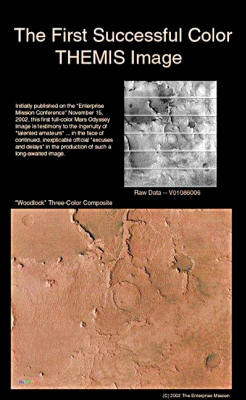
Compare this striking, full color result to the "raw" data file from
ASU (below).
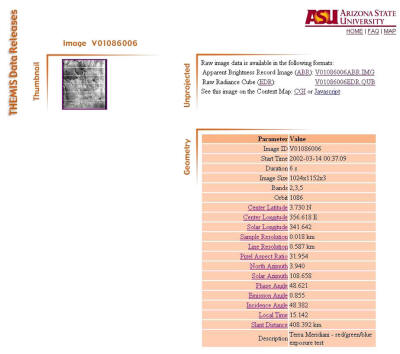
Note that the official record calls this a "red/green/blue exposure
test"...
-
So - what went wrong with the rest of the "test?"
-
What delayed the THEMIS Team’s (apparently still unsuccessful!) attempts to turn this
image into their own full color view?
-
In other words, what has the THEMIS Team been doing all these months
- since this image was
acquired, on March 14, 2002?!
And, how come Heald - a carpenter by trade, and an admitted
"imaging amateur" - was somehow able to resolve - alone, and in
just over a month (from the time when the image first appeared, in
the October 1 PDS release) - the "intractable imaging problems"
(the light leaks and geometric differences between the bands,
apparent in even this raw data) that, according to "Bamf," have
delayed ASU’s official publication of any "natural color" THEMIS
images... for over a full year?
Inquiring minds...
Reaction to "Woodlock’s" impressive amateur achievement has been
mixed: dead silence from NASA’s THEMIS Team (expected...), and
cautious admiration from various independent Mars researchers in the
field.
However, amid the praise, more than a few of these
independent minds (starting with Gary Leggier’s - aka "Mars
Revealer") have raised some relevant questions regarding the
ultimate accuracy of Jim Heald’s color.
In particular, the
distinctly "salmon" hues...
Their
suspicions have a reason...
Some independent researchers (such as the persistent Robert Williams
- who has been perhaps the most vocal individual across the Web,
asking now for months, "Where’s Odyssey’s real color?!") have slowly
become convinced that the primary reason NASA has been "dragging its
feet" for over a year on this otherwise "golden PR issue"
- the
first Real Color Images of Mars from orbit - is because accurate,
full color images will ultimately reveal to all the world NASA’s
"dirty little secret":
The existence of wide spread areas down there of tell-tale green -
indicative (one would then easily believe) of current living
organisms... Martian plant life... NOW on Mars!
For these investigators, the Woodlock three-color image - though,
indeed, containing tantalizing (if subtle) hints of "green"
- does
not go far enough.
Another "amateur" - Holger Isenberg, himself an investigator of
NASA’s strange historical habit of arbitrarily altering the colors
of its own Mars images (the "JPL story") - within a few hours,
produced another version of "Woodlock’s" color view (below). In
it, not only do the reddish tints become more vivid, but the darker
areas now take on an unmistakable "green hue"...
Heald responded:
"Holger got some [interesting] results in his stretched version of
my image... A little scary I had not done that, yet Shows that there
is a depth to these layered color images, even if each layer starts
off at a very low contrast. I'm thinking that would make my photo 'unenhanced'.
Not a problem..."
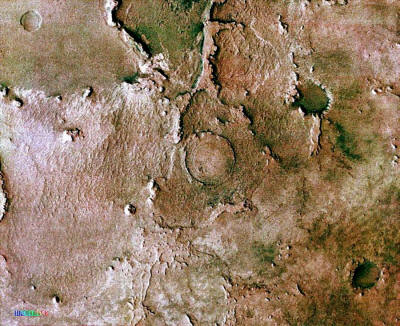
So, is it vegetation?
A more prosaic possibility is the presence of the distinctly
greenish mineral, "olivine." The rational for a lot of this ancient,
very "primitive" volcanic compound lying around on the current
Martian surface in the "Terra Meridiani" region (where Heald’s image
was acquired) can be found in our "Mars Tidal Paper."
And here (below) is a larger context graphic of the entire area -
starting with another enlargement of Atonio Cidadao’s remarkable
1999 Mars image (remember - taken with a 10-inch telescope; look at
the detail!), compared with the official NASA-ASU THEMIS map of all
Odyssey’s visible light images to date.
This comparison reveals
that, indeed, the aggregation of innumerable small patches of this
"greenish stuff" seen in "Woodlock’s close-up (and even more so in
Isenberg’s enhancement) is probably now responsible for the overall
shape and darkness of this Martian surface pattern, classically
called "Meridiani Sinus" ("Terra Meridiani" in the current NASA
designation).
Note also the "salmon color" - of both Mars deserts in Cidadao’s whole-disc image, and in Heald’s processed ultra-close-up.
They’re the same...
In other words: "Woodlock" got it right!
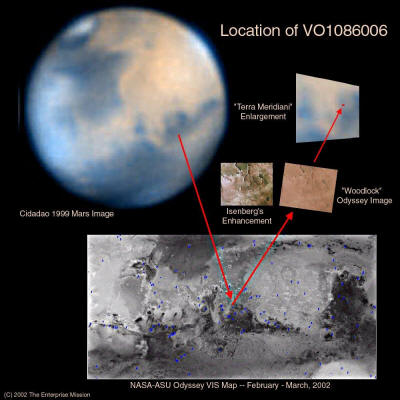
So, again the question must be asked:
what’s the "green stuff?"
Because, in looking one more time at Cidadao’s truly extraordinary
image, it’s clear that Mars is actually not "red"… but definitely
salmon pink - just as it appears visually through any decent
telescope.
And, he’s not the only one...
As you can see (below), other amateur astronomers worldwide, armed
with a wide range of comparably small telescopes and CCD cameras,
are recording the same "salmon colored" planet... year after year
- complete with "blue-green" markings.
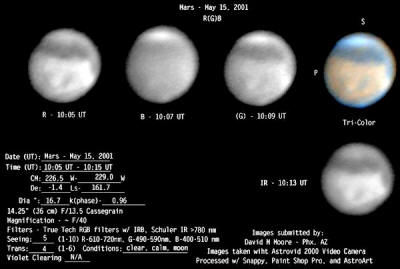
This is in sharp contrast to NASA’s various space views (below)
-
which are literally "all over the map," in terms of "true Mars
color."
This curious (and also totally inexplicable) fact is blatantly
attested to by the variety of official NASA images that Jim Heald
has patiently collected on his website. Note that, with the same
instrument (the Hubble Telescope), NASA has published since 1995 at
least five different versions of "the Red Planet" (and that’s not
counting various additional shades returned by cameras aboard
assorted U.S. spacecraft orbiting the planet!).
Only one - taken in 1995 - resembles the characteristic "salmon
pink" that amateurs routinely have observed...
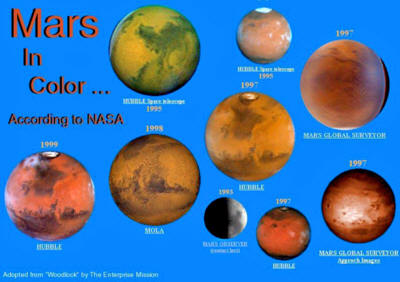
So, what’s the meaning of all this?
The actual colors of Mars, long before NASA’s apparent inability to
present consistent images, have been historically crucial (if not
also intensely controversial) to an accurate understanding of what
is taking place on the Red Planet.
This has been true ever since the first known amateur observations,
by Franciso Fontana (from Naples) in 1636.
Fontana produced the
first crude maps, noting "the disk of Mars is not uniform in color."
A later observer, Dutch astronomer Christiaan Huygens, in 1659, drew
the first still recognizable triangular-shaped feature (Syrtis
Major).
He also made what could be termed the first scientific
(comparative) observations of the colors of the planet, in a
manuscript titled "Kosmotheroros" (1798).
"I am apt to believe that the land in Mars is of a blacker color
than that of Jupiter [sic] or the moon, which is the reason for his
appearing of a copper color."
The first astronomer to render drawings of Mars in color was Jesuit
Father Angelo Secchi, Director of the Gregorian University
Observatory in Rome.
Secchi’s primary work in the mid-1800’s
involved exploring the possibilities of the newly-invented
spectroscope, as applied to ferreting out the chemical make-up of
celestial objects. While he was eminently successful with the stars,
his visual observations of planets - in an effort to determine their
very different chemistries and physical conditions - was far too
early, in terms of the state of the technology, to be successful.
In 1858, however, he did produce the
first color drawings and maps of Mars - which showed the dark areas
as shades of green, and the lighter areas as "tints of yellow"...
With an eye trained by looking through his spectroscope at literally
thousands of multi-colored stars, in all their myriad hues, it is
noteworthy that none of Secchi’s maps depict Mars as a "red" planet
- unlike NASA...
Slightly over a hundred years later, in 1894, perhaps the most
famous "amateur" astronomer of all, Percival Lowell, would
poetically compare the colors
he observed on Mars to those of the
Southwestern deserts surrounding what was about to become his famed
"Lowell Observatory" - assembled on "Mars Hill," in Flagstaff,
Arizona:

"The resemblance of its [the Arizona deserts’] lambent saffron to
the telescopic tints of the Martian globe is strikingly impressive.
Far forest and still farther desert are transmuted by distance into
mere washes of color, the one robin's-egg blue, the other roseate
ochre, and so bathed, both, in the flood of sunshine from out of a
cloudless burnished sky that their tints rival those of a fire-opal.
None otherwise do the Martian colors stand out upon the disk at the
far end of the journey down the telescope's tube. Even in its mottlings the one expanse recalls the other..."
Earl C. Slipher, a later, noted planetary astronomer at Lowell (and
brother of then Lowell Director, Vesto Slipher - who himself
discovered the infamous "redshifts" of distant galaxies at Lowell,
which would then launch Hubble at Mt. Wilson on his eventual career...) would write of these dark "mottlings":
"[Their] presence on Mars indicates a living world: vegetation. The
evidence is in the blue-green areas and the changes in their
appearance. Vegetation would present exactly the appearance shown,
and nothing we know of but vegetation could. The seasonal change
that sweeps over them is metabolic; that is, it shows both growth
and decay and proclaims an organic constitution such as only
vegetation could produce.
The blue-green lapses into ochre and
revives again to blue-green just as vegetation does on Earth at the
proper season under the stimulus of the Sun and the advent of water.
Certain large dark areas, like the Pandorae Fretum, turn to
chocolate-brown and ochre at times, the color of dead planets and
fallow ground.
"These seasonal changes of the dark areas have long been interpreted
as vegetative even though the atmosphere is now almost devoid of
free oxygen. If there was enough oxygen to sustain life, and if the
exhaustion by weathering were exceedingly slow, it is conceivable,
but not considered probable, that the evolution of life may well
have kept pace with it.
Plants may have developed means of utilizing
for their own internal respiration the oxygen produced by
photosynthesis, just as desert plants on Earth have learned to store
up water and protect themselves from evaporation..."
(The
Photographic Story of Mars, E.C. Slipher, Northland Press,
Flagstaff, AZ, 1962)
Not all telescopic observers, however, were so easily convinced.
Astronomers who used large reflecting telescopes to observe Mars
(with primary mirrors that collect the light), as opposed to large
refractors (which use big objective lenses), noted important visual
differences in the apparent "colors of Mars."
Edward Emerson Bernard, one of the 19th and 20th Century’s great
telescopic observers, had visually studied (and drawn) the planets
for decades... by looking through the telescope. Bernard
traditionally did his looking through the 36-inch refractor at the
Lick Observatory (just south of San Francisco), and the 40-inch
refractor at the Yerkes Observatory (northeast of Chicago) - still
the two largest refracting telescopes in the world.
Refractors of
this great size have an intrinsic engineering problem: bringing all
the colors of the spectrum to the same focus (because light refracts
differentially through the crown and flint glass "objective")
-
unless additional, special color-correcting lenses are introduced.
Reflectors (even big ones), which collect their light with simple
parabolic mirrors that reflect all light waves evenly, don’t suffer
this intrinsic "color problem."
When Bernard got a chance to visually observe Mars through the newly
built 60-inch reflector on Mt. Wilson in 1911 (then, the largest
telescope in the world), he was reportedly amazed that the bright
regions of Mars were,
"… a very feeble salmon - almost free of color" (see recent
drawings, done by Harold Hill, while visually observing through a
10-inch reflector - below).
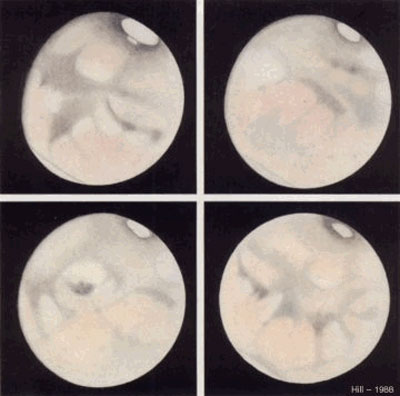
Bernard’s view of the controversial dark markings
- that Lowell
(also using a 24-inch refractor on Mars Hill) had lyrically
described as "robin’s egg blue" - was that they appeared,
"…painted with a grayish paint supplied [sic] with a very poor
brush, producing a shredded or streaky and wispy effect."
Some decades later - during the same ’56 opposition that
Robert
Leighton used to photograph Mars on color film with that same
telescope from Mt. Wilson - another well-known astronomer, Gerard Kuiper, carried out a completely different color experiment a
thousand miles away.
Kuiper used the 82-inch reflector at the
McDonald Observatory (in Texas), to visually compare the subtle
Martian features with a set of standard laboratory color charts,
representing some "200 different hues."
Kuiper set up his charts inside the well-lit 82-inch dome (so his
eyes were "normal," rather than being "night adapted" and thus
insensitive to subtle color hues), and arranged it so that he could
look at Mars visually through a binocular eyepiece at the huge
telescope, and also (via a beam splitter configuration) at the color
charts about 3 feet away.
In this way, with a magnification of 900
times, he could instantly flip back and forth, comparing the planet
- which, with that magnification, appeared about 12 times larger
than a full Moon as seen with the naked eye from Earth (!) - with
the "200 different hues"...
Kuiper’s conclusion: the dark markings seemed to be,
"a neutral gray... essentially the same hue as the adjacent deserts but diluted with
black." Other areas did display some subtle tints, ranging from
"slightly brownish" to "a very dilute moss green."
("The Colors of Mars: Reality and Illusion," T. Dobbins and W.
Sheehan, Sky and Telescope, April, 1999, pp116-120)
Which is precisely what Jim Heald’s unenhanced Odyssey color image
clearly now reveals - amid the salmon pink, some intriguing, "mossy"
hues ...!
Some critics of the historical tendency to see the color "green" on
Mars, explain away all these the observations thus: that a
phenomenon called "simultaneous contrast" is responsible.
That,
"[This psychological phenomenon, discovered in 1839 by a French
chemist, M. E. Chevreul] causes colored highlights to impart their
complementary hue to any adjacent low-luminosity features...
Viewed
against a bright ochre background [the Martian deserts], a dark
neutral gray marking will take on an illusory bluish green cast.
(ibid)
The major problem with this "explanation," is that modern amateur
astronomer’s objective CCD cameras - which are not psychologically
susceptible to "simultaneous contrast" or any other "optical
illusions" - are also faithfully recording these same provocative
"blue-green and salmon" hues (Cidadao image - below)...
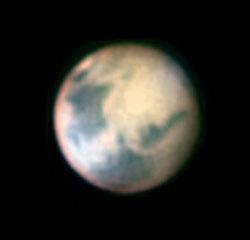
In the mid-1960’s, another attack on the premise that the
"greenish-looking, seasonally changing, Martian surface markings are
waxing and waning vegetation" suddenly arose: the wind was doing it.
Based on studies of terrestrial sand dune formations, including one
most famous work published in 1941 by English naturalist, R.A.
Bagnold, and later analysis of the first primitive Mariner 4 Mars
images in 1965 (by NASA space scientists such as James Pollack and
Carl Sagan), the majority of planetary scientists in the late 50’s
gradually came to believe that the long-mysterious "dark markings"
on Mars were merely, in truth, wind-sculpted, dark volcanic
features.
This view was solidified in 1971, when Mariner 9’s much
better spacecraft imagery revealed thousands of "wind streaks"
-
dark and light markings - stretching out across the dark and lighter
regions of the planet, emanating from myriads of Martian impact
craters into previously erupted dark, "basaltic" lava.
In this model, the long-observed seasonal changes which have
fascinated Mars observers since those first telescopic observations
centuries ago, were casually reduced to "dust deposition changes"...
ultimately caused by seasonal variations in the winds... The
long-mysterious dark markings, in this view, were not - are not -
"evidence" of Life on Mars... not plants, nor trees, nor "alien"
greenish organisms...
The alterations of Mars’ makings were merely due to miles of
shifting, ancient, wind-born volcanic ash and pumice...
Part II
So... if its only “blowing dust and buried craters”...,
-
Why has NASA
gone to such elaborate, documented lengths, across so many years and
missions, to systematically confuse the situation regarding Mars
real colors?
-
And why are they still doing it... with
THEMIS?!
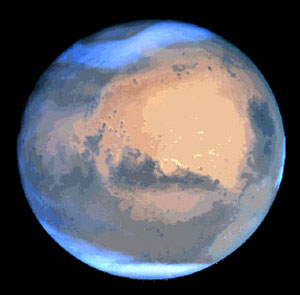
In fact, there’s an even larger, far more fundamental question.
Why, with so much prior evidence gathered in the 1950’s - that
“something” is cyclically altering the Martian landscape, over
literally millions of square miles, twice each season, and in a
literal “wave of darkening” which extends toward the equator from
both poles in their respective Martian Springs... on a planet thought
even then to be geologically extinct (the “dying planet” model left
by Lowell...) - why was there not more scientific curiosity about
what was actually causing such dramatic Martian planetary changes?!
Set against the backdrop of all those Grade-B “invaders from Mars”
movies of the 1950’s - and on the eve of the first human spacecraft
that could ultimately go there and find out! - why was there not
more interest in “something” so provocatively “Martian”... green...
and changing?
“Something” which, for a time, even showed the tell
tale organic spectral signature of carbon-hydrogen bonds (and, then,
provocatively only in the darker areas - below)?
“Something” demonstrating a signature on Earth clearly indicative of
living vegetation.
These provocative spectral observations were carried out at two
close Mars oppositions, by Harvard University astronomer, William
Sinton - in 1956 and ‘58!
-
Why weren’t they ever followed up?
-
Why
was the eventual partial “explanation” to Sinton’s historic organic
molecule detection never actually redone - by later and far more
sophisticated telescopic (or spacecraft) observations... including
with the Hubble?
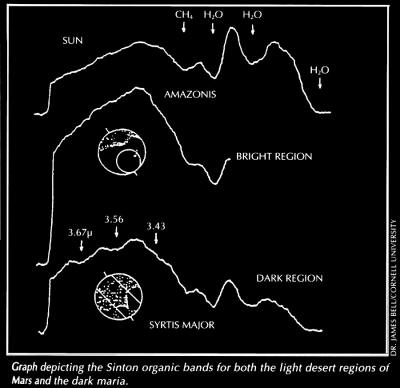
The eventual published “refutation” of Sinton’s evidence was that
two of “Sinton’s three organic bands” were actually due to an
unusual form of “duterated water” in the atmosphere of Mars. [But,
remarkably... only in the darker (vegetation?) areas...?]
Later, the
“proof” that Sinton was mistaken in his original organic
identification was discovered to have been contaminated by heavy
water lines in Earth’s own upper atmosphere - leaving completely
untouched Sinton’s original, provocative, organic Martian
observations. But still... no follow up.
And, the mystery of the third “Sinton IR band” - at 3.45 microns,
which on Earth is definitely due to organic carbon-hydrogen
transitions - also never was resolved...
Given the prevailing social and scientific climate of the times, as
to the likelihood of “some form of current Martian life” - even if
only “lowly vegetation” - the rapid, public shift of astronomers’
perspectives in the late 1950’s... from almost frenzied interest in
the subject, to the current “lifeless” NASA Mars... even before the
disappointing Mariner 4 images in 1965... in hindsight is another,
most perplexing puzzle...
Unless, of course, “something else” quietly occurred... “something”
that was able to shift all astronomers’ perspectives... through their
funding (which, even then, was coming almost solely from the Federal
Government... and NASA).
Can you say “Brookings?”
It is remarkable, given the prior history of intense public and
scientific interest, that this increasingly negative astronomical
perception regarding Mars as a potential "abode of life" -
curiously, led by highly visible NASA-funded scientists... such as Kuiper, Leighton, Sagan, et al
- began to change precisely
"coincident" (we now know) with the intensely controversial
sociological research project being quietly conducted in the late
1950’s for an official NASA document, "The Brookings Report."
An
official government-sponsored Study which forecast civilization’s
ultimate demise... with scientific confirmation of ANY life outside
the Earth!
Regardless of whether these two events were mere "coincidence," from
that time forward, the Space Agency publicly proceeded along two
simultaneous tracks:
-
always dangling the prospect of the "imminent
discovery of Life beyond the Earth" (including Mars) at almost every
official opportunity and on every NASA mission - to continue to
gain crucial funding from an "interested public" via Congress
-
while, simultaneously, downplaying every solid scientific discovery
which would confirm "it may have found it"... or, even conditions
which would make it much
more likely
As I’ve noted in my chronicle of this decades-long "official
schizophrenia," "The Monuments of Mars," it’s a clear case of "jam
yesterday... jam tomorrow... but NEVER jam today..."
This documented, carefully calculated, blatantly contradictory NASA
policy regarding "life on Mars" has continued right into the current
"2001 Mars Odyssey Mission" - with its official naming after Arthur
Clarke and Stanley Kubrick’s seminal film about the discovery of
life beyond the Earth, "2001."
You know, the classic 1968 movie
depicting a future "NASA’s" history-changing discovery of
extraterrestrial artifacts... which it then promptly "covers up"...
because of National Security... including, from the very astronauts
sent to investigate the evidence themselves!
Should we be surprised, then, that a Mars Mission officially
carrying the mantle of this major "ET cover-up movie" of all time...
the famed "2001"... should be behaving a little "peculiarly" itself?
One potential answer to this continuing paradox may lie in the other
information that an accurate, official Odyssey color image could
provide...
The Odyssey THEMIS camera has five narrow-band filters, as can be
seen from both the spectrum chart (below), and Table 4.4 from
Odyssey's pre-Mission Proposal Information Package (PIP).
These
bands are unevenly spaced across the visible and near-infrared
region of the spectrum (below).
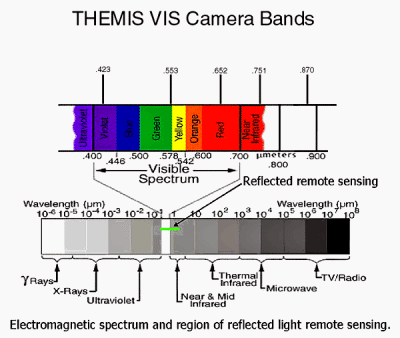
In addition to reconstruction of visible color images from the three
shortest-wavelength bands (2, 5,and 3 - below), the camera also can
"see" into the near infrared (bands 1 and 4) - which is where the
reflectance data (as opposed to the thermal emission recorded by the
other section of the THEMIS camera) most easily indicates certain
material compositions of the surface.

According to "Bamf," posting in the
MarsNews.com Forum:
"The VIS bands were chosen to coincide with discriminating
absorption features for several families of ferrous oxides and
ferrous silicates, while still being close enough to the human
visual system to produce accurate true-color images.
The [thermal] IR bands were chosen to coincide specifically with absorption
features for carbonates and to cover the range of features for
several families of silicates, sulfates and several other families
of minerals. Band 10 was chosen to fall in the middle of the CO2
absorption feature for atmospheric monitoring and to facilitate
atmospheric removal..."
In light of Jim Heald’s obvious accomplishment
- the production of
the first Odyssey color image from these filters - his opinion on
their selection is equally relevant:
"…Odyssey isn't close [to accurate visible wavelengths], so it's my
contention that the idea is to average bands. 425 and 540 to get
450(blue) 540 with 425 to get 520(green) and 654 with 749 to get 680
being RED. Not sure what band 860 is for (scratching head) but it
has not shown up in the QUB file as any thing that is remotely
usable...???
Now these color bands are compatible with the PSP RGB
color combiner. Think the data is very practical and we can get a
good idea of what is going on down there... at NASA."
Funny you should mention that mysterious
"860-micron band," Jim...
Note again the apparent discrepancy between the PIP - which lists
"870" as this center near-IR wavelength - and the current number
(860) quoted by Jim Heald, which is the one also listed on the ASU
official THEMIS website.
If you read Bamf’s statement again - and
carefully - it is implied that the "860/870 micron band" is
included in his recitation of the VIS selections...BUT... he then
says,
"…still being close enough to the human visual system to
produce accurate true-color images." And, of course, that cannot
correspond to an infrared wavelength of "860/870 microns!"
Which
means he’s not referring to the two IR bands at all?!
What’s their purpose, then?
Partial confirmation of Bamf’s statement about the mineralogical
detections with these filters comes from similar filter selections
on a predecessor NASA mission, Mars Pathfinder, which landed on Mars
in 1997.
The Pathfinder camera parameters (on the Lander) were
published in the JGR-Planets "Special Mars Pathfinder Issue," in
late 1996:
"The first objective [of the Pathfinder multi-spectral IMP
investigation] is identify the crystalline ferric oxides,
oxyhydroxides, the poorly crystalline or nanophase ferric oxides.
The major crystalline ferric oxide phases include hematite,
goethite, maghemite, magnetite, and lepidocrocite (Morris et al.,
1985).
The basaltic weathering product palagonite is an example of a
material that has visible to near-IR spectral properties doninated
by nanophase ferric oxides (Morris et al., 1989,1990). The
spectrally diagnostic region for these minerals is primarily in the
UV to 860 nm range using 8 of the filters.
This allows for
discrimination based on four spectral parameters (Bell and Morris,
1995):
-
the position of the ferric iron UV drop-off (diagnostic
of goethite, maghemite, magnetite, and lepidocrocite)
-
the
position of the charge transfer band near 860 nm (diagnostic of
hematite, goethite, maghemite)
-
the presence of a charge
transfer band near 650 nm
-
the presence of a band between
650 and 800 nm.
The depth of features at these diagnostic band-passes
can provide information on the crystallinity of the target material
[emphasis added]..."
From these specifications, determination of Martian mineralogy via
multi-spectral imaging would appear to have been the primary public
objective of Mars Pathfinder... and now (according to Bamf) Mars
Odyssey.
But... is that all?
One indication that there might be "more"... came from a surprising
Mars Pathfinder development, announced just this past Spring:
the
sudden presentation - at the Second Astrobiology Conference,
sponsored by NASA-Ames in April, 2002, in Mt. View, California - of
a paper, readdressing the potential discovery of chlorophyll on Mars... this time by the Pathfinder Lander!
The find was, according to the
researchers, made by a reassessment of multi-spectral imaging data
acquired by the Mars Pathfinder IMP (Image for Mars Pathfinder)
camera system.
According to the NASA-Ames abstract:
"… we searched for the spectral signature associated with red light
absorption by chlorophyll... we plotted a full spectrum for the
involved pixels and carefully examined the images. The condition was
met for small areas in six image cases. All of these cases occur in
near field images, where resolution is highest.
Four of the cases
occur on the spacecraft and appear to be associated with spacecraft
structure. Two intriguing cases occur in small areas on the ground
near the spacecraft [emphasis added]."
What makes this so intriguing is that shortly after the Pathfinder
landing, in 1997, Pathfinder IMP Principal Investigator, Dr. Peter
Smith (University of Arizona), announced the results of an initial
multi-spectral scan for chlorophyll... and came up empty.
But, in 2002, members of his own imaging team (this time at
NASA-Ames) suddenly announced new findings... totally revising
Smith’s initial 1997 negative assessments re chlorophyll at the
Pathfinder landing site!
So, just what is "chlorophyll" - and why is it so important to a
Martian "picture story?"
According to
a standard definition:
"Chlorophyll is the molecule that absorbs sunlight and uses its
energy to synthesize carbohydrates from CO2 and water. This process
is known as photosynthesis and is the basis for sustaining the life
processes of all plants. Since animals and humans obtain their food
supply by eating plants, photosynthesis can be said to be the source
of our life also..."
From this, it is obvious that confirmed detection of this crucial
molecule - required of all known plant life here on Earth - would
move both the scientific and political debate re "Life on Mars" to
an entirely new level... including the discussion of
"intelligently-designed artifacts."
The problem: as we noted
earlier, there have been repeated, Earth bound telescopic searches
for this critical pigment, going back over a hundred years... the
latest (Sinton’s) in 1958... and none have turned up unassailable
evidence for its existence on the Red Planet.
Which makes the announcement of the suddenly "revised" Pathfinder
results this Spring so politically "coincidental."
For, only a few months (September) after this surprising NASA-Ames
announcement, some media outlets (but, far fewer than carried the
Pathfinder "discovery"), carried another "chlorophyll Mars story"
-
this time, about the little-known work of a "Dr.
Serguei
Mikhailovich Pershin."
Pershin is a Russian space scientist, who, in 1985, developed a
space borne, remote-sensing laser experiment for the 1988 Russian Phobos Mission.
In 1996, another of his experiments - a compact
aerosol backscattering lidar ("light detection and ranging" laser
instrument), capable of measuring the composition of the Martian
atmosphere from a balloon or landed spacecraft - won a competition
for inclusion by NASA on the ill-fated 1999 Mars Polar Lander
Mission. (Pershin’s instrument was the first and only experiment
from Russia to be flown on a United States Mars mission.)
In 1998, Pershin - utilizing narrow-band images taken with the
Hubble Telescope, and computer-processing them as multi-spectral
band ratios - initiated the first follow-up to Sinton’s
controversial observations in forty years... announcing that he’d
discovered strong indications of red chlorophyll pigment
fluorescence (induced by ultraviolet solar energy) from
certain
regions of the planet.
These curiously enhanced regions (below, far
right) were similar to narrow-band enhancements he’d detected in his
laboratory laser experiments, using UV lasers as remote sensing
tools to excite the chlorophyll emissions from a variety of
terrestrial soil samples.
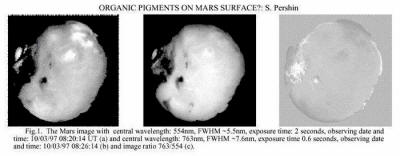
Pershin’s conclusions, even as a Russian scientist only loosely
associated with NASA, were carefully "politic":
that he’d discovered
only "relic organic pigments… from potentially former living
organisms...", but not evidence of current Martian life. In truth,
raw ultraviolet light reaching the Martian surface would quickly
destroy any exposed "fossil chlorophyll."
So, if Pershin’s results
are valid, they have to be produced by living organisms!
His recommendation for follow-up was equally conservative:
"We sure that this approach can be applied for satisfactory relict
organic pigments [chlorophyll] detection and 2-D mapping from the
Earth or Mars Orbiter without landing using Mars image with high
spectral resolution in blue-red range..."
In other words: close-up, narrow-band, multi-color imagery from
Odyssey would be a perfect way to confirm Pershin’s pioneering
chlorophyll results... if the filters were "properly" selected!
If we examine the spectrum of chlorophyll itself (below), we begin
to see some remarkable "convergences" - between Pershin’s
understated Hubble data... and the potentially real (though hidden)
reason for the selection of the current Odyssey VIS filters.
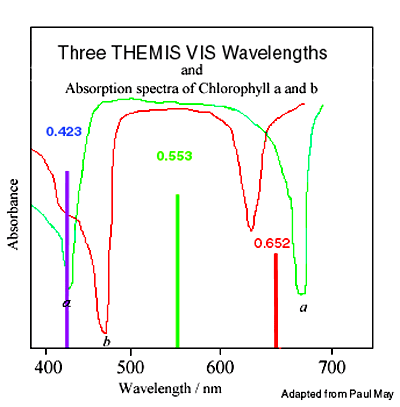
As can be seen from this spectral graphic, there is in fact more
than one type of chlorophyll (the two depicted here are termed "a"
and "b").
All are essentially the same molecule, differing only in
some side chains and in the type of photosynthetic organism in which
they are found. All are essential to the photosynthetic process, and
together have complementary abilities to absorb and convert solar
energy into crucial carbohydrates across the entire visible region
of the spectrum.
According to the
Odyssey PIP, the shortest-wave VIS filter (above)
- at 0.423 microns - falls precisely where the well-known
short-wave absorption of sunlight due to chlorophyll "a" is
greatest! Beside it, the "green VIS filter" at 0.553 microns, is
located at the "green peak" in the chlorophyll reflection spectrum
(which is why plants appear "green" to human eyes); and the "red
band" (at 0.652) is situated just to the long wave side of the "b"
absorption maximum, and just to the short wave side of the
chlorophyll "a" absorption trough.
In other words - Bamf’s "detection of iron oxides" notwithstanding
- the visible THEMIS VIS filters (selected just after Pershin
published his intriguing Hubble chlorophyll results, in 1998), also
seem precisely tuned to both detection of standard chlorophyll
absorption bands (above)... or... for detecting Pershin’s solar UV
"pumped" chlorophyll fluorescence emissions (below)!
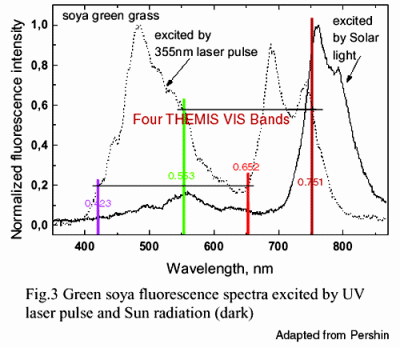
If the filtered Odyssey VIS images depicted here are then ratioed in
the computer (via ENVI or its equivalent) according to Pershin’s
Hubble protocol (above), a remarkable thing will happen - if
Odyssey images a patch of fossil chlorophyll (or, current
chlorophyll-containing plants...)
As noted, unfiltered Martian
ultraviolet (similar to Pershin’s "355 micron" ultraviolet laser
pulses - dotted line, above) reaches directly to the surface.
Thus - if chlorophyll is down there - images through the four carefully
chosen VIS filters shown here - properly divided into one another
- will reproduce the same exact ratio (horizontal lines - above)
on Mars, compared to Pershin’s terrestrial lab results!
The chances of this happening "by accident" (look at the diagram,
again... and note carefully the slopes of the chlorophyll
absorptions and emissions, where the filters have to be placed to
create these precise ratios!) is astronomical...
Thus, a unique determination of the presence of past (or, far more
likely, present) living plant life on the Martian surface - and in
an image with 18-meters/pixel resolution -will be produced. This, in
turn, will heavily - but quietly, judging by NASA’s past performance
- influence the entire landing site selection process for future
surface exploration... including the upcoming Mars Exploration Rover
(MER) Missions, landing in 2004.
Unless - it already has - and we don’t yet know it.
Oh, and what of that fifth, "useless" 860/870 micron band, discussed
before?
If you extend the spectral graph into the near-IR (below), it is
immediately apparent that the two near-IR THEMIS bands are also
precisely positioned to measure the non-fluorescence, standard
infrared spectrum there of chlorophyll as well.
The first near-IR
band ( 0.751) has obviously been picked to precisely define the
so-called "red edge" of Martian chlorophyll-bearing organisms.
The so-called "red edge"
is defined in
remote sensing as,
"The point of maximum slope on the reflectance spectrum of
vegetation between red and near-infrared wavelengths... is correlated
strongly with foliar chlorophyll content and provides a very
sensitive indicator of, among other things, vegetation stress.
"Red Edge" detection has become the key test for the presence of
chlorophyll in terrestrial aerial and satellite multi-spectral
imagery. It has also recently been tested (via "Earthshine"
reflected from the Moon) as a means of detecting chlorophyll in the
spectra of distant "extrasolar Earth-like planets".
The second THEMIS near-IR band - the
"useless" 860/870-micron filter (below) - has obviously now been
selected for Odyssey as a "control" for the preceding "red edge"
confirmation... to verify the first chlorophyll reflection peak
beyond the "red edge" position in the infrared.
This will differentiate a successful
detection of the chlorophyll signature from potentially confusing
iron-oxide spectra...
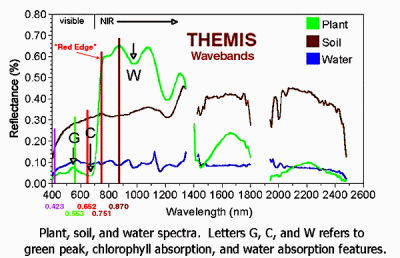
Here is an example from Arizona (courtesy of
Debi A. Scott) of what
infrared photography beyond the "red edge" looks like (below).
Note
the brilliant appearance of the vegetation (due to high reflectance
in the near-IR), compared to the background, iron-oxidized Arizona
"Mars-like" rocks...
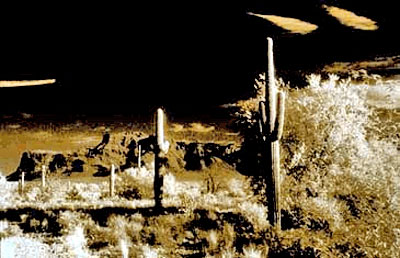
Again, that all these THEMIS filter selections and chlorophyll
wavelength match-ups could occur "just by chance"... is simply
inconceivable.
It should now be apparent what this latest aspect of the "NASA Mars
game" has truly been about:
If the THEMIS team had officially produced a true color image early
in the Mission, the entire range of questions regarding its color
authenticity, and the reasons for the precise selections of the
Odyssey filters discussed here... would have arisen much too soon.
And, if there’s one thing we have learned in trying to understand why NASA does anything
surrounding Mars... it is that everything must happen on a
"timetable."
Is that the reason for this key exchange, between Jim Burk,
Editor-in-Chief of MarsNews.com, and "Bamf" a couple weeks ago, even
before Heald produced his striking color THEMIS image?:
<Burk> Since there is so much controversy swirling around this
particular [color] data, it would be a good idea for the NASA/ASU/THEMIS
data experts to perform their own professional processing rather
than let just anybody perform the task and possibly be accused of
"doctoring" the colors.
<Bamf> I didn't say we weren't doing it, I said we should be capable
of doing it by December.
Is Gorelick saying here (again, between the lines) that, by December
of 2002, the "timetable" finally will be "ready" for Odyssey’s true
color... and the flood of deeper questions that will follow?
For, if Odyssey has quietly confirmed the signature of chlorophyll
on Mars, if the "muted green tones" that Heald has now produced are
any indication of what we can expect when the THEMIS Team decides to
officially announce... the implications are indeed profound.
Remember, the sole function of chlorophyll is,
"…a molecule that
absorbs sunlight and uses its energy to synthesize carbohydrates
from CO2 and water."
From Odyssey’s other major experiment - the
Gamma Ray Spectrometer -
we now know that beneath the salmon
colored Martian deserts lies a veritable frozen planetary ocean.
And, the atmosphere of Mars, as we’ve known for over thirty years,
is essentially pure CO2.
Put all these facts together, and suddenly Mars changes - from the
decades of NASA driven "spin" re "an environment hostile to any form
of life" (except maybe a few struggling, tiny microbes...) - to a
land of extraordinary possibilities for all varieties of life...
including (per the Tidal Model) intelligence itself!
Where even "Arthur’s Bushes" - named for my long-time friend,
Arthur C. Clarke (below), who first brought their remarkable
existence near the Martian south pole to the attention of the space
community -
could now be real.
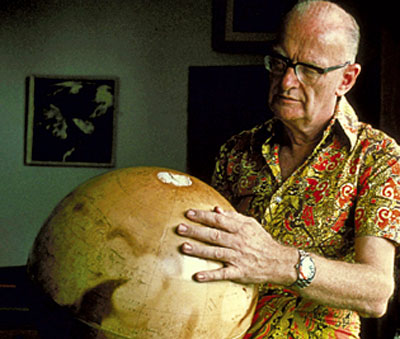
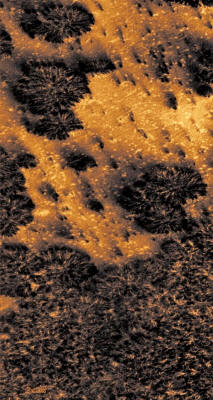
In the Fifth "2001" Edition of "The Monuments of Mars," dedicated to
Arthur’s eerie vision in the making of the film, we ventured the
following prediction about "his" NASA Mission:
"Mars Odyssey’s extremely sophisticated color/IR camera... will allow
direct testing of this crucial aspect of the model: the Odyssey
camera, via its ability to sense up to fifteen spectral bands across
the visible and infrared, may directly detect the chlorophyll
signature of any Martian plant life currently alive on Mars
(Arthur’s immensely controversial ‘trees’ and ‘bushes’)..."
Thanks to Jim Heald, in a few days now
- if Bamf’s "December
deadline" is another "coded message" - we may know...
Bulletin - "Still Up to Their Same Old Tricks..."
Just as we were finishing this analysis of Odyssey’s expected THEMIS
color, JPL finally released precisely
such an image, right on cue,
in total conformance with their self-imposed "December 2002
deadline" (strongly hinted at by "Bamf," several days ago).
The official "excuse," of course, is that the release was timed for
this week’s
annual AGU Meeting (American Geophysical Union), being
held in San Francisco. Ironically, the major planetary sessions’
theme is titled: "Fundamental Discoveries in Planetary Science: The
Color of Worlds I..."
And, in fact, the Meeting
began on Friday, December 6th.
In fact, the timing of the JPL THEMIS weekend release is in full
compliance with the other Rituals we’ve fully come to expect from
JPL... as December 7th (you guessed it) is another "19.5 date" on
the Ritual Calendar they use...
Anyone amused?
As to the image itself: presented here (below, left) is the JPL
official color version... compared to one we simply lightened (below,
right), by applying a gamma correction of 2.10. Note that, seen with
Jim Heald’s striking prior effort (bottom, left), and an
(uncensored!) amateur Mars image, taken with a telescope from Earth
(bottom, right), JPL’s concept of what Mars’ color truly is, after
almost 30 years, is once again, obviously... way too red.
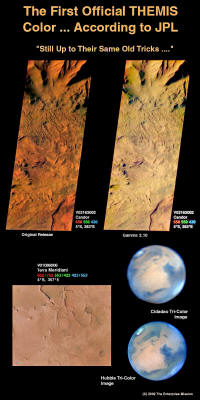
At this week’s AGU meeting, a paper was presented describing the
“scientific” calibration procedures for this initial THEMIS color
image: “Calibration and Initial Analysis of Multi-Spectral Images of
Mars from the VIS Subsystem on the Mars Odyssey THEMIS
Investigation.”
In it, the authors specifically state:
“We validate our derived radiances [Mars surface brightness] by
comparing regions observed by VIS and HST/WFPC2 over the same
wavelengths and during the same Martian season...”
In other words, the authors claim their calibration procedures
involved careful comparison of the Odyssey’s VIS imagery with the
same regions photographed by Hubble!
This official procedure is, of course, precisely the same process we
followed - in “recalibrating” the published Hubble color Mars
imagery (which, as Jim Heald has documented, is anything but
“consistent”) with the one standard we found which was consistent...
uncensored amateur astronomers’ tri-color CCD Mars imagery.
As can be seen by comparing this Mars imagery (above - middle right)
with the “corrected” Hubble data (above, bottom right), and Jim Heald’s own pioneering THEMIS
color...
JPL has obviously “blown it” once again!
As everyone can see, just as they did 26 years ago with the first
full color Viking surface image, JPL has once again literally
destroyed most of the information presented in this heavily
distorted version of the THEMIS color - which, when simply
lightened, reveals a remarkable range of myriad subtle shades and
saturations actually recorded by the THEMIS camera...
These colors
are obviously more accurate - when compared with what Mars simply
looks like in an amateur telescope - than JPL’s “official” version... including, several multiple green hues!
So, for JPL, the “color game” regarding Mars apparently continues...
Now, just what do you suppose the computer-rationed version of this
image also shows... compared to Dr. Pershin’s protocol for
chlorophyll? And, any bets on when they plan to finally tell us
that…?
|





































